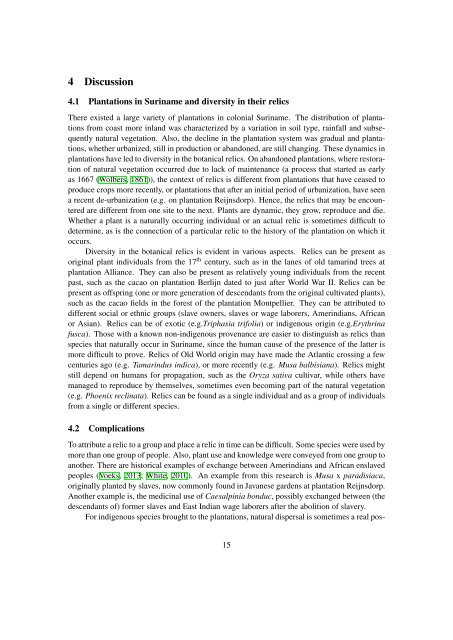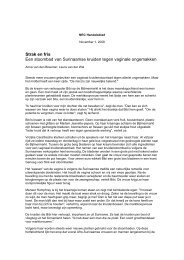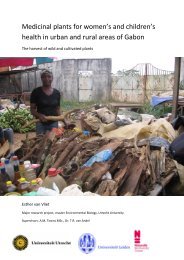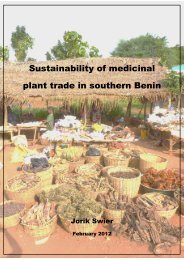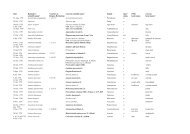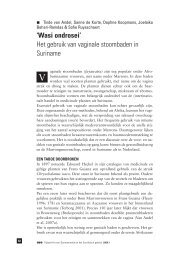T. Heilbron 2012.Botanical relics of the plantations - osodresie
T. Heilbron 2012.Botanical relics of the plantations - osodresie
T. Heilbron 2012.Botanical relics of the plantations - osodresie
You also want an ePaper? Increase the reach of your titles
YUMPU automatically turns print PDFs into web optimized ePapers that Google loves.
4 Discussion<br />
4.1 Plantations in Suriname and diversity in <strong>the</strong>ir <strong>relics</strong><br />
There existed a large variety <strong>of</strong> <strong>plantations</strong> in colonial Suriname. The distribution <strong>of</strong> <strong>plantations</strong><br />
from coast more inland was characterized by a variation in soil type, rainfall and subsequently<br />
natural vegetation. Also, <strong>the</strong> decline in <strong>the</strong> plantation system was gradual and <strong>plantations</strong>,<br />
whe<strong>the</strong>r urbanized, still in production or abandoned, are still changing. These dynamics in<br />
<strong>plantations</strong> have led to diversity in <strong>the</strong> botanical <strong>relics</strong>. On abandoned <strong>plantations</strong>, where restoration<br />
<strong>of</strong> natural vegetation occurred due to lack <strong>of</strong> maintenance (a process that started as early<br />
as 1667 (Wolbers, 1861)), <strong>the</strong> context <strong>of</strong> <strong>relics</strong> is different from <strong>plantations</strong> that have ceased to<br />
produce crops more recently, or <strong>plantations</strong> that after an initial period <strong>of</strong> urbanization, have seen<br />
a recent de-urbanization (e.g. on plantation Reijnsdorp). Hence, <strong>the</strong> <strong>relics</strong> that may be encountered<br />
are different from one site to <strong>the</strong> next. Plants are dynamic, <strong>the</strong>y grow, reproduce and die.<br />
Whe<strong>the</strong>r a plant is a naturally occurring individual or an actual relic is sometimes difficult to<br />
determine, as is <strong>the</strong> connection <strong>of</strong> a particular relic to <strong>the</strong> history <strong>of</strong> <strong>the</strong> plantation on which it<br />
occurs.<br />
Diversity in <strong>the</strong> botanical <strong>relics</strong> is evident in various aspects. Relics can be present as<br />
original plant individuals from <strong>the</strong> 17 th century, such as in <strong>the</strong> lanes <strong>of</strong> old tamarind trees at<br />
plantation Alliance. They can also be present as relatively young individuals from <strong>the</strong> recent<br />
past, such as <strong>the</strong> cacao on plantation Berlijn dated to just after World War II. Relics can be<br />
present as <strong>of</strong>fspring (one or more generation <strong>of</strong> descendants from <strong>the</strong> original cultivated plants),<br />
such as <strong>the</strong> cacao fields in <strong>the</strong> forest <strong>of</strong> <strong>the</strong> plantation Montpellier. They can be attributed to<br />
different social or ethnic groups (slave owners, slaves or wage laborers, Amerindians, African<br />
or Asian). Relics can be <strong>of</strong> exotic (e.g.Triphasia trifolia) or indigenous origin (e.g.Erythrina<br />
fusca). Those with a known non-indigenous provenance are easier to distinguish as <strong>relics</strong> than<br />
species that naturally occur in Suriname, since <strong>the</strong> human cause <strong>of</strong> <strong>the</strong> presence <strong>of</strong> <strong>the</strong> latter is<br />
more difficult to prove. Relics <strong>of</strong> Old World origin may have made <strong>the</strong> Atlantic crossing a few<br />
centuries ago (e.g. Tamarindus indica), or more recently (e.g. Musa balbisiana). Relics might<br />
still depend on humans for propagation, such as <strong>the</strong> Oryza sativa cultivar, while o<strong>the</strong>rs have<br />
managed to reproduce by <strong>the</strong>mselves, sometimes even becoming part <strong>of</strong> <strong>the</strong> natural vegetation<br />
(e.g. Phoenix reclinata). Relics can be found as a single individual and as a group <strong>of</strong> individuals<br />
from a single or different species.<br />
4.2 Complications<br />
To attribute a relic to a group and place a relic in time can be difficult. Some species were used by<br />
more than one group <strong>of</strong> people. Also, plant use and knowledge were conveyed from one group to<br />
ano<strong>the</strong>r. There are historical examples <strong>of</strong> exchange between Amerindians and African enslaved<br />
peoples (Voeks, 2013; White, 2010). An example from this research is Musa x paradisiaca,<br />
originally planted by slaves, now commonly found in Javanese gardens at plantation Reijnsdorp.<br />
Ano<strong>the</strong>r example is, <strong>the</strong> medicinal use <strong>of</strong> Caesalpinia bonduc, possibly exchanged between (<strong>the</strong><br />
descendants <strong>of</strong>) former slaves and East Indian wage laborers after <strong>the</strong> abolition <strong>of</strong> slavery.<br />
For indigenous species brought to <strong>the</strong> <strong>plantations</strong>, natural dispersal is sometimes a real pos-<br />
15


